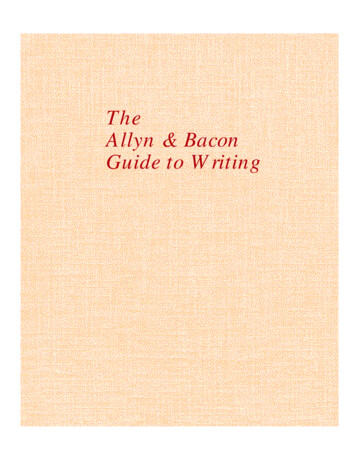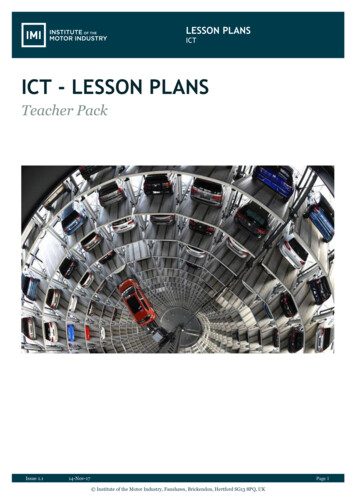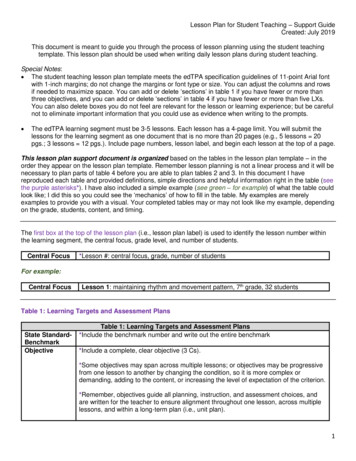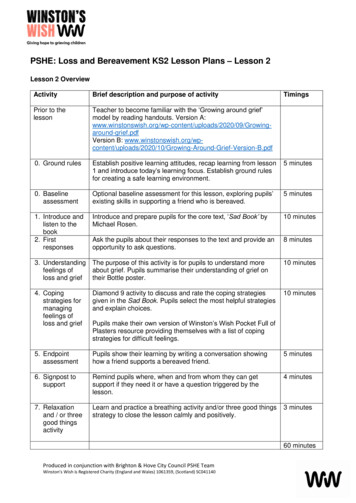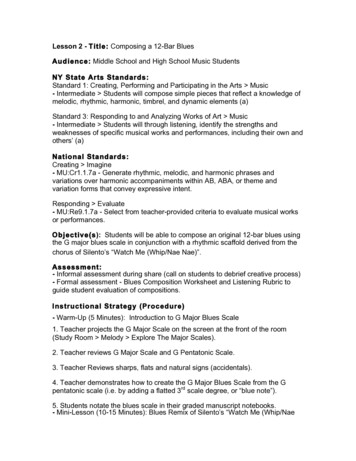
Transcription
Lesson 2 - Title: Composing a 12-Bar BluesAudience:NY State Arts Standards:Standard 1: Creating, Performing and Participating in the Arts Music- Intermediate Students will compose simple pieces that reflect a knowledge ofmelodic, rhythmic, harmonic, timbrel, and dynamic elements (a)Standard 3: Responding to and Analyzing Works of Art Music- Intermediate Students will through listening, identify the strengths andweaknesses of specific musical works and performances, including their own andothers’ (a)National Standards:Creating Imagine- MU:Cr1.1.7a - Generate rhythmic, melodic, and harmonic phrases andvariations over harmonic accompaniments within AB, ABA, or theme andvariation forms that convey expressive intent.Responding Evaluate- MU:Re9.1.7a - Select from teacher-provided criteria to evaluate musical worksor performances.Objective(s): Students will be able to compose an original 12-bar blues usingthe G major blues scale in conjunction with a rhythmic scaffold derived from thechorus of Silento’s “Watch Me (Whip/Nae Nae)”.Assessment:- Informal assessment during share (call on students to debrief creative process)- Formal assessment andtoguide student evaluation of compositions.Instructional Strategy (Procedure)- Warm-Up (5 Minutes): Introduction to G Major Blues ScaleTeacher projects the G Major Scale on the screen at the front of the room.Teacher reviews G Major Scale and G Pentatonic Scale.Teacher Reviews sharps, flats and natural signs (accidentals).Teacher demonstrates how to create the G Major Blues Scale from the Gpentatonic scale (i.e. by adding a flatted 3rd scale degree, or “blue note”).Students notate the blues scale in their graded manuscript notebooks.- Mini-Lesson (10-15 Minutes): Blues Remix of Silento’s “Watch Me (Whip/Nae
Nae)Teacher plays VIDEO of Blues Remix of Silento’s “Watch Me (Whip/NaeNae)”.Teacher asks, “What is the same about this remix of “Watch Me (Whip/NaeNae)” and the what is new or different than the original?”Students turn-and-talk (Expected student responses: SAME - The melody isthe same, the tempo is the same. DIFFERENT - The chords are different, therhythm is different.)Teacher plays a short video clip which demonstrates how the rhythm of“Watch Me (Whip/Nae Nae)” has been extrapolated into a 12-bar blues form togenerate the “City” worksheet”.- Work-Time (30 Minutes): 12-Bar Blues Composition “The CityBlues”Teacher will distribute theworksheets. Each table willreceive one example of a successfully composed 12-bar blues worksheet.Teacher will circulate the room and provide support to students needing helpcompleting assignment.Teacher will perform 5 or 6 successfully completed compositions on thekeyboard using theas backing.Students will listen and use their assessment rubrics to evaluate the finalcompositions.- Sharing (5-10 Minutes)1. Teacher will call on students to debrief the lesson asking questions like:“What makes a melody memorable?”“What makes a melody easy to sing?”“What could you do differently next time to improve your melody?”(Expected responses from students will be “repeating phrases & patterns,stepwise motion and that they can use combinations of the above toimprove their melody writing.”)2. Teacher will call on one student to reiterate the learning target for the lesson,which is “I can compose an original 12-bar blues in G by combining a G MajorBlues Scale scale with the chorus rhythm from Silento’s song “Watch Me(Whip/Nae Nae)”.Materials:
Computer with Chrome, Safari or Firefox to access the PULSE website.Projector, PA system.“CityBlues” 12-Bar Blues composition worksheetBlues remix of Silento’s “Watch Me (Whip/Nae Nae)”ideoSong evaluation rubric with two criteria (melody & entertainment value)
Lesson 3 - Title: Cultural and Technological Factors of the BluesAudience: 7th Grade Music - ICT Class (Inclusive)NY State Arts Standards:Standard 4: Understanding the Cultural Dimensions and Contributions of the Arts Music- Elementary Students will identify the primary cultural, geographical, andhistorical settings for the music they listen to and perform (c)National Standards:Responding Analyze- MU:Re7.2.7b - Identify and compare the context of music from a variety ofgenres, cultures, and historical periods.Common Core Standards ELA- Grade 7: 2a-f - Write informative/explanatory texts to examine a topic andconvey ideas, concepts, and information through the selection, organization, andanalysis of relevant content.Objective(s): Students will be able to:- Understand and discuss the socio-political factors that gave rise to the Blues.- Understand and discuss technology’s influence on shaping musical genres.Assessment:- Informal assessment through class discussion.- Formal assessment: compare and contrast essay on music of today and thepast and technology’s impact on musical genresInstructional Strategy (Procedure)- Warm-Up (10 Minutes)Teacher asks, “What did we do last class?” (Expected responses are that weused “Watch Me (Whip/Nae Nae) to compose a new song; we completed the“CityBlues” worksheet; we composed a 12-Bar Blues song)Teacher asks, “What is the rationale behind composing a 12-Bar Blues?”(Expected response is that The Blues is America’s first homegrown musicalgenre)Teacher asks, “Where did The Blues come from?” (Expected response is frompeople in the south)Teacher asks, “Who were these people, and why were they there?” (Responseis open ended)Teacher directs conversation towards a discussion about the historical roots ofthe blues, including slavery, African tribal music (slaves) and European folk music(slave owners).
- Mini-Lesson (10-15 Minutes)1. Play “Take Me To The River” Clip 1 from berkleepulse.net website- Work-Time (30-35 Minutes – Provide Blues Essay worksheet in Arabic andSpanish for ELL students; Provide additional scaffolding for IEP students withsentence starters printed on the back of the worksheet; Read directions out loudfor slower readers.)1. Teacher projects VENN diagram of musical genres on the projection screen2. Teacher calls on students to interpret the meaning of the diagram (Expectedresponse is that it shows three primary musical genres comprised of AfricanMusic, European Folk Music, and Delta Blues, with various sub-genres related tothese)3. Teacher hands out the Blues Essay worksheet with the VENN diagram onfront and lined essay paper on the back.4. Teacher has students write a compare and contrast essay that compares themusic of today and the music of the past. Consider how culture and technologyinfluenced the creation of the blues in the American south. (Note: Providesentence starters for struggling writers and IEP students.)- Sharing (5 Minutes)Call on a student to share the learning target in his or her own words using an “Ican” statement (e.g. “I can understand how culture and technology influenced thecreation of the blues in the American south)Materials:1. Computer with Chrome, Safari or Firefox to access the PULSE website.2. Projector, PA System.3. "Take Me To The River" Movie Clip #1 (Study Room Take Me To The River Introduction Movie Clip #1 – Introduction)4. Blues Essay Worksheet.
M u s i c Wr a p a r o u n d6th Grade WraparoundUnit #1 - FORM“C Jam Blues” by Duke Ellington, “Crazy” by Gnarls Barkley, “I Wanna Be Sedated” by The Ramones, “Rock With You” by MichaelJackson, “Crazy In Love” by BeyoncePerformance Notes“C Jam Blues” by Duke Ellington and and “I Wanna Be Sedated” by The Ramones are well suitedfor the beginning guitar ensemble as both are based on I - IV - V chord progressions which willprovide an easy entry point to learn left hand facility.Music MakingUse “C Jam Blues” and “I Wanna Be Sedated” as a starting pointto teach the I - IV - V chord progression. Easy versions of both theC and G chords can be played by using only one finger on the lefthand and muting strings 4, 5 & 6 with a paper towel. Thisprovides the I and V chords in the key of C Major. In thebeginning have students “sit it out” or “bench it” on all occasionsof the F chord (IV chord).Using Little Kids Rock curriculum, teach students LESSONPLAN 1: Holding the Guitar; LESSON PLAN 2: Parts of theGuitar; LESSON PLAN 3: Naming Guitar Strings; LESSONPLAN 4: Guitar Technique; LESSON PLAN 5: Holding a Pick;LESSON PLAN 6: Fret Numbers / PositioningComposition and Improvisation:Introduce the 12 bar bluesUsing the fifth and sixth notes of the C Pentatonic Scale (A &C) encourage improvisation by having students play variousrhythmic combinations over the 12 bar blues formSinging is highly beneficial for instrumental students.Incorporate singing into every lesson. Students can improviseby scatting syllables on the A - C notes over 12 bar blues.Use additional repertoire based on I - V progressions to enhancestudents’ experience with one finger chords. The Beatles“Paperback Writer” and “Eleanor Rigby” can be used. Sing &Play.Music LiteracyUsing the aboverepertoire, students willlearn to identify anddescribe the followingsong forms:verseverse-refrainbinary (A/B or versechorus)complex binary(AABA, verse-choruswith bridge, 32-barstandard)12-bar bluesStudents will also be ableto identify and describethe following sections of apiece of music:introverseintroductory verserefrainchorusbridge (primary andtransitional)codaSuggested ResourcesTeachout, Terry. Duke: A life of Duke Ellington. Penguin Group,USA, 2013.McNeill, Legs. ’Please Kill Me, The Uncensored Oral History OfPunk’. Penguin Group, USA, 1997.Southern, Eileen. The Music of Black Americans. 3d ed. NewYork: W. W. Norton, 1997.MakingConnectionsDuke Ellington wasbased in NYC from themid 1920s onwards, andbecame famous throughhis frequent appearancesat The Cotton Club inHarlem.The Ramones were anAmerican Punk RockBand that formed inQueens and began theircareer playing in themusic clubs on NYC’slower east side, like thehistoric CBGBs.While discussing 20thcentury American historyand its music-historyparallels (including thehistory of jazz, AfricanAmerican music, PunkRock & R&B), studentslisten to variousrecordings representativeof these genres.Community and CulturalResourcesListen to cover versions of “CJam Blues” by various NYCbased artistsInform students about thecbgb.com web-siteSchedule a school visit by ateaching artist to performselections from repertoire listCareers and LifelongLearningDiscuss the band leader’s jobDiscuss the roles of thevarious members of the bandand how they work togetherDiscuss the role of the lyricistDiscuss the use of time as abarometer of musical qualityDiscuss the ways in whichvarious societal advancementshave affected instrumentproduction, recordingtechnology, and popular tastes
Lesson 2 AssessmentsBlues Composition WorksheetComposer (Your Name):Class #Date:G Major Blues ScaleDirections: Use the staff below to compose a melody for the “CityBlues” by using random notes fromthe G Major Blues Scale (above) and the rhythms from the chorus of Silento’s “Watch Me” (written outbelow). The first two measures have been completed as an example. When composing, please rememberthe following: (1) Use every note at least once (2) You may repeat notes up to 3x in a row (hooks)(3) Stepwise motion is easier to sing than skips (4) Your melody should end on a G
Blues Composition Listening RubricYour Name:Class Number:Date:Table Group #1CATEGORY4321MelodyThe melody issimple enough fora child to singalong.Most (over half) ofthe melody issimple enough fora child to singalong.Part of the melodyis simple enoughfor a child to singalong.The melody isdifficult to sing ORrecall.EntertainmentValueThe entire song is Most of the song ishighly entertaining. entertaining.The song issomewhatentertaining.The song is notentertaining.CATEGORY4321MelodyThe melody issimple enough fora child to singalong.Most (over half) ofthe melody issimple enough fora child to singalong.Part of the melodyis simple enoughfor a child to singalong.The melody isdifficult to sing ORrecall.EntertainmentValueThe entire song is Most of the song ishighly entertaining. entertaining.The song issomewhatentertaining.The song is notentertaining.CATEGORY4321MelodyThe melody issimple enough fora child to singalong.Most (over half) ofthe melody issimple enough fora child to singalong.Part of the melodyis simple enoughfor a child to singalong.The melody isdifficult to sing ORrecall.EntertainmentValueThe entire song is Most of the song ishighly entertaining. entertaining.The song issomewhatentertaining.The song is notentertaining.Overall Grade:Notes:Table Group #2Overall Grade:Notes:Table Group #3Overall Grade:Notes:
Lesson 3 AssessmentsBlues EssayYour Name:Class #Date:Write a compare and contrast essay that compares the music of todayand the music of the past. Consider how culture and technologyinfluenced the creation of the blues in the American south.1. Africa/African Music2. America/Jazz3. Europe/Folk Music4. America/Rhythm & Blues5. America/Soul6. America/Rock & Roll7. America/Delta Blues
Blues Essay (sentence starters for struggling writers)
9@ C#BN HBN :# N MC ! 5#N *B#!E ;C N C#NE(#NCE %%N #1 JNE N! 8@ C#N N8#1 "LN % BNE)#N ELN HC*!N 1H#D N LNGC ;'NB ;" 9N; E#CN&B 9NE)#N N 0 BN 1H#CN ! 1#N I# N ;"NE)#NB(LE(9CN&B 8NE)#N!( BHCN &N ,3#;F CN F!)N # N JB-FE# N HEN #4 J N (#N%/BCFNEJ N 8# CHB#CN( I N ##;N! :@5#F#"N CN ;N #K 8@6# N )#;N! 8A C ;' N @1# C#NB#9#9 #BNF)#N% 17?J.;' N " # ! " !. &444 4444-444-.4 44& C44 !/ &4 2 4 %)4 4!/ '44 4-4!. &4!0 &4-.44 44& C44 !1 &4 2 4 %(4 4 -4 -.44 444& C4 -5 ) !. &44 4-4 -.44 444& C4 % 4 2 4 %*4 4 2 4 % 4 4 % 44 *34*34 4 -44 -4 % 4-4-4 % 4 2 4 %,4 4
Composition and Improvisation: Introduce the 12 bar blues Using the fifth and sixth notes of the C Pentatonic Scale (A & C) encourage improvisation by having students play various rhythmic combinations over the 12 bar blues form Singing is highly beneficial for instrumental students. Incorporate singing into every lesson. Students can improvise


